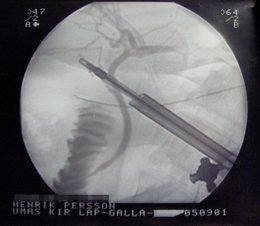Approximately 500,000 cholecystectomies are performed annually in the United States. Symptomatic gallstones are the most common indication for cholecystectomy. A review by Ahmad and colleagues stressed the importance of differentiating biliary colic and acute cholecystitis. Overlapping symptoms may result in misinterpretation.
Approximately 90 percent of gallstones are composed of cholesterol. Gallstones are most likely to develop in patients with supersaturation of bile products, bile stasis or nucleation factors (i.e., mucin, glycoproteins and calcium around which a stone may form). Risk factors for cholesterol gallstone formation include age, obesity, rapid weight loss, pregnancy, female sex, use of exogenous estrogens, diabetes, certain gastrointestinal conditions and certain medications.
About one third of patients with gallstones develop biliary colic or other complications. Colic pain is precipitated by spasm of a dilated cystic duct that is obstructed by gallstones. Attacks of biliary colic are more common at night, possibly because the gallbladder shifts to a horizontal position, facilitating the entry of stones into the cystic duct. Biliary colic is characterized by the sudden onset of intense right upper abdominal pain that may radiate to the shoulder. Sweating and vomiting are common. The pain tends to be steady and lasts up to three hours. Residual abdominal tenderness may occur.
Pain in the area of the gall bladder lasting more than three hours is characteristic of acute cholecystitis. The most common cause is cystic duct obstruction by gallstone(s), and the initial symptom may be epigastric pain. A pain-free interval may occur before symptoms shift to the right upper quadrant. Older patients may have only localized tenderness. As local inflammation becomes more intense, signs and symptoms of tenderness and a local mass can be complicated by systemic toxicity manifested by fever and leukocytosis. The classic Murphy's sign (abrupt interruption of deep inspiration) is elicited by palpation of the gallbladder area. A palpable mass caused by inflammation and adherent omentum is present in 30 to 40 percent of patients with cholecystitis. Abdominal guarding in response to deep palpation is common. Up to 15 percent of patients with acute cholecystitis are jaundiced.
Acalculous cholecystitis is more common in older male patients with serious conditions. Bile statis is the proposed underlying mechanism. Complications develop more rapidly than in patients with calculous cholecystitis. Pathogens can colonize the gallbladder mucosa, creating a carrier state and increasing the risk of future episodes of acute cholecystitis.
Laboratory results are usually normal in patients with biliary colic. Leukocytosis with bandemia is a frequent finding in patients with acute cholecystitis (see the accompanying table), and mild elevations of serum aminotransferase levels may occur within a few hours of onset. Amylase levels may also be elevated as a result of transient obstruction of the pancreatic duct. Obstruction of the common hepatic duct or common bile duct can result in hyperbilirubinemia.
Ultrasonography has high sensitivity and specificity for gallstones but a lower yield for stones in the ductal system. Up to one half of stones in the common bile duct are not detected on ultrasonography. In the gallbladder, stones less than 2 mm in diameter may be missed or misdiagnosed as sludge. Endoscopic retrograde cholangiopancreatography is the test of choice to detect stones in the common bile duct.
Unless the gall bladder is calcified or the patient has other risk factors, asymptomatic gallstones may be managed expectantly. Because 70 percent of patients with biliary colic will have a second episode, surgery may be advised. In patients with acute cholecystitis, prompt surgery is recommended.
COPYRIGHT 2000 American Academy of Family Physicians
COPYRIGHT 2000 Gale Group



